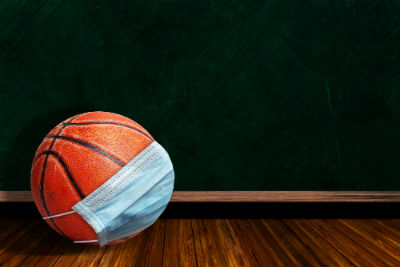
It was weird, to say the least, being in a college basketball arena in 2020-2021, with fans largely shut out, at most, in Virginia, at least, 150 people in the seats.
Odd thing: they still sold popcorn and a few other concessions.
Other than that, it was like watching a practice.
A Virginia Tech economics professor and two colleagues from other universities tried to determine the impact of COVID on college hoops, with a focus on whether fan restrictions during the 2020-21 season impacted traditional home-court advantages often enjoyed by teams playing in home venues.
Jadrian Wooten, a collegiate associate professor in Virginia Tech’s Department of Economics in the College of Science, worked with Emily Marshall, a collegiate associate professor of economics and data analytics at Dickinson College, and Stephen Locke, an associate professor of economics at Western Kentucky University, on the project, which yielded not surprising results.
“Fans definitely matter,” Wooten said. “I think almost any sports fan is going to tell you that fans matter, especially once they go, and so what we were really curious about was how much they matter.”
The group examined three factors expected to impact home-court or home-field advantage — fans, familiarity with the venue, and travel-related issues.
Prior to the pandemic, separating the influences of those three was hard, though many studies have made attempts.
The pandemic offered the researchers a rare opportunity to take an in-depth look at the fan aspect.
“We’ve never really had a situation where fans just completely disappear,” Wooten said. “And it happened for almost everybody, and so this was slightly different.
“It took us a while to think about how to frame it, because we normally think about the more fans, the better, and so we were looking at it as if you lose a lot of fans, what’s the impact?” Wooten said. “If you’re a small team, if you’re Radford University and you lose a few fans, it doesn’t really matter, but if you’re Kentucky, Kansas, or Duke, and you lose all your fans, that’s going to make a big impact. We’re kind of doing the reverse of, if I have a lot of fans versus losing a lot of fans. It was really the first chance to isolate the fan side of it across a wide variety of teams.”
The group analyzed data from all 358 Division I teams that play college basketball. To be able to make a comparison, the group looked at game-level data from the 2019-2020 season and the season right after with pandemic-induced restrictions, 2020-2021.
The data encompassed more than 7,300 games.
The group focused its attention on four main categories — who won or lost the game, the scoring margin, field-goal percentage, and free-throw percentage. Typically, a team wins and shoots better both from the field and the free-throw line when playing at home.
The group found that the home team won 63.2 percent of the time in the season before the pandemic, with that number dropping to 58.9 percent during the pandemic season. In the season before the pandemic, the home team won by a margin of 4.29 points per game, but that margin dropped to 3.1 points per game during the pandemic season.
Overall, the numbers supported the group’s hypothesis that fans matter.
“That effect was even stronger in games played between two what we’re calling ‘Power 6’ teams,” Marshall said, referencing teams from the ACC, BIG EAST, Pac-12, Big Ten, SEC, and Big 12. “Those teams are used to playing in front of more fans. The impact of taking away fans is stronger for those teams. With that, the probability that the home team winning falls when we take away fans.”
The lack of fans also impacted field-goal and free-throw shooting percentage differentials, though only slightly. The home team still shot better from both the floor and from the free-throw line than the visitors in both seasons, and the margin of difference was less than a percentage point.
“I think the biggest surprise to me is the free-throw percentage differential,” Marshall said. “I would have expected the fans behind the baskets to be doing a little bit more. We also don’t find in that set of results a big difference between the Power 6 conferences and the non-Power 6 conferences, whereas I would have thought that it would have mattered a lot more in the games played between two teams in the Power 6 conferences [because of larger crowds]. So that, to me, is the most surprising result.”
Wooten and Marshall collaborated on a 33-page full academic paper of their results (Locke collected the data for analysis). They have submitted the paper for peer review in hopes of having it published.
They admitted that they started this project because of their interests in sports and because of a fun curiosity. But their research also serves as an incentive to get students interested in economics and analytics.
“It’s easy for students to understand, and it’s a nice teaching tool for me,” Marshall said. “I think it’s something that really captures student interest. … It’s always nice to have a story like this to tell to help students really kind of get interested in the subject.”
And perhaps there is something for athletics departments around the nation to learn. Fans matter. They impact winning and losing, and the numbers support it.
“I think it shows that the value of the fans is really there,” Wooten said. “I’ve been in a couple of different places where it didn’t seem like they necessarily cared whether fans were there or not. They’re like, ‘Oh, cool, we’ve got fans. Fantastic,’ especially smaller schools where you get into games for free. That was my undergrad experience [at Sam Houston State University]. You didn’t pay for games, and in their minds, they’re like, ‘Oh well, if you’re not going to come in if it’s free, we’re not going to try to recruit you to come here anyway.’
“Recruit fans to go to the games. I think a lot of this paper says that you should probably actually be paying a little bit more attention to them, if you really are trying to win these games.”










